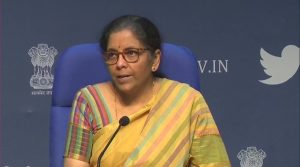
Prof SN Misra
Finance minister Nirmala Sitharaman has been unveiling a slew of major initiative to resuscitate MSMEs, power sector, migrant workers, farmers etc. These are essentially intended to provide increased sinews to the Make in India initiative, christened Atmanirbhar Bharat. Reforms are also announced for encouraging FDI in defence sector, corporatization of Ordinance factories and for greater capital acquisition from indigenous sources.
Economic liberalization started in the defense sector in 2001 by encouraging 100 per cent private sector participation and 26 per cent FDI. Earlier it was the preserve of 39 factories and eight defence PSUS. This has given a nudge to the Make in India initiative. The Kelkar Committee (2005) made a powerful plea to provide a level playing field to the private sector. The decision to increase the FDI limit to 74 per cent is indeed a masterstroke. This is also a policy of China. This will help India garner partnership with major foreign OEMs like Lockheed Martin and Boeing.
The other major recommendation has been to corporatize the 40 ordinance factories which produce arms, tanks, ammunition, and low tech clothing items. Unlike the defense PSUs which have considerable autonomy, India’s defense ordinance factories are cesspools of inefficiency, poor quality, high cost and lack of accountability. It enjoys the protection of the government against a slew of complaints from the defense services, ranging from poor clothing, ill-fitting shoes and poor ammunition. The Kelkar Committee had suggested that the Ordinance factories be corporatized. However, the powerful trade unions of 1.5 lakh ordinance factory employees have successfully checkmated the government’s moves in this direction.
The third major plan of the FM is to encourage the Make component by preempting imports in certain areas. Now, nearly 70 per cent of India’s defense arsenal is imported. While the present initiative is for continuation of the earlier announcements to deny global tenders up to `200crore to encourage purchase from MSMEs, the move to replicate it for defense products is most regressive. There is always a raging debate in the defense ministry between the services and the DRDO, whether the services should be happy with what they provide as second best.
The FM’s plan is also for making India a Manufacturing, Repair and overall (MRO) hub. In the last budget, she had also suggested that the tax concession would be extended for setting up such MROs. At present, MRO is a big business globally accounting for nearly $45billion. India accounts for less than 1 per cent of this. Most of the ROH of civil aviation platforms and military platforms are done abroad. MROs require massive capital investment, quality manpower, tooling and proper certification and safety arrangement. India can be an ideal MRO destination with its skilled manpower and excellent IT base.
It has been assessed that the cost of ROH of aviation platform like Jaguars and Su-30 will cost 30 per cent less compared to their ROH cost abroad. This is indeed an opportunity for defense PSUs like HAL and defense shipyards like MDL to invest in ROH facility, thereby bringing down the humongous cost that ROH entails when overhauled abroad. The FM has suggested that the GSQR (General Staff Quality Requirement) should be realistic. These are old arguments being revived again possibly to dilute the qualitative requirement needed by the defense services for pandering to supply by domestic suppliers. This is again a veiled attempt to encourage low-skilled products from indigenous suppliers as against a global tender which will give India the best of defence products at realistic costs and acceptable quality.
Defence production and acquisition of weapons system have been part of the free trade regime where the defense services set the tone of quality requirement. Any policy which seeks to compromise and belittle such a robust arrangement under the shenanigan of Atmanirbharta is both ill-conceived and a compromise in security imperatives. The Kalam Committee in 1993, after extensive study, had assessed India’s Self Reliance Quotient to be only 30 per cent and had recommended that this be increased to 70 per cent by 2005, by augmenting research and testing facility. DRRO’s track record in indigenization of Propulsion, Avionics and Weapons has been rather poor. Its Joint Design Development venture in MR SAM with Israel has been edifying.
The writer is a retired joint secretary with Aerospace department.

0 Comments